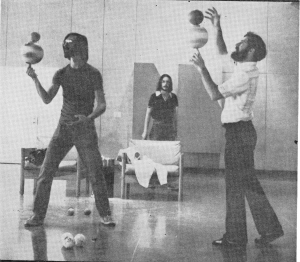
As Chris Kearney watches, MIT jugglers Arthur Lewbel (l) and Andy Rubel spin balls on balls. (Bri Serog photo) |
Page 18 December 1982
|
MIT
jugglers
claim history, technology By Arthur Lewbel Boston, MA
In
April of 1976, a half-dozen jugglers who were attending MIT
Unicycle Club meetings decided to
separate and form the MIT Juggling Club. We continued to meet at the
same time and place as the uni's did, Sunday afternoon in front of the
MIT Student Center.
Over
six years later, we still meet at the same time and place as long as
the weather is nice enough to suit our persnickety jugglers (not too
hot, cold, sunny, rainy, or windy). Otherwise, we meet in the lobby of
MIT's building 13.
This
club was not the origin of juggling at the Massachusetts Institute of
Technology, however. Earlier, MIT's Artificial Intelligence
Laboratory studied jugglers and juggling from the point of view of
how people learn a skill. One student, Howard Austin, wrote his entire
thesis on the subject. In part, he analyzed how jugglers build up
sequences of reflexes in their hands, that are called on by the brain,
much as a computer program receives information from the outside, and
processes it by calling on prearranged subprograms.
Juggling
at MIT often seems to get technical. Although the majority of our
members are not associated with the school, the spirit of the place sometimes
creeps in. For example, David leDoux, a past president, created decks
of computer punch cards whose holes would appear to move in juggling
patterns when you thumbed through the deck. Professor Halold Edgerton,
inventor of the strobe light, has taken pictures of club swingers and
jugglers under his lab's powerful strobes. The juggler featured in a
recent book of Edgerton's photos is Skip King, a former MIT Juggling
Club member.
Mathematics
professor Claude Shannon, who recently appeared in JUGGLERS WORLD
magazine, is from MIT. In addition to building juggling machines, he has
done original research into the mathematics of juggling.
He
notes, for example, that the geometry of standard juggling patterns are
invariant under affine transformations, although the ability to stretch
or distort patterns in this way is limited by physical conditions, such
as necessary minimal relationships between the time objects spend in the
air and the time spent in the hand. Moving away from toss juggling, MIT
has produced machines that can balance a pole, and students here built
what was once the world's largest yoyo.
All
of this activity has little to do with the MIT Juggling Club, however.
The club is just a center for jugglers in the Boston area to meet,
practice, trade ideas, and talk to each other, away from Harvard Square
and the street scene.
We
have no dues, one functional officer, and require no affiliation with
MIT for membership. In fact, we don't even have a membership list. By
always meeting at the same time and place, the club is available to any
juggler with a Sunday afternoon to spare.
The
meetings have a small core of avid regular attendees, and a hoard of
every-nowand-then'ers. Attendance varies greatly from week to week.
The range of ability in our members is also large. A few local
performers, such as Rawd Holbrook of the Fantasy Jugglers, AI Jacobs,
Michael Kass, Judy Gaiten, Dario Pittore show up most weeks. Some of our
nonperformers are also very good, including some
At
our meetings, we of course juggle and talk about juggling. Club passing
is popular here. Fads, from counting three ball variations to fire
eating, have come and gone, though year after year the club remains
essentially unchanged.
How
did all this come about? For me, it began in the spring of 1973 when,
after two years of juggling on my own, I met John Grimaldi. He told me
about the IJA, and about his juggling workshop at Trinity Church in
Manhattan. When I came to
MIT, I joined the unicycle club, and began
bringing my juggling props to meetings. Some of the other
unicyclists learned to juggle, and other jugglers seemed to drift in
from nowhere. We soon started our own juggling club, modeled on John's
New York workshop.
I
was elected the first president, and David Mark
(Spiderman the Juggler) was vice president. Among other things,
David ran the first and only MIT juggling and unicycle club show.
Back
then, club members were almost entirely MIT students. As we became more
established, the club started attracting outsiders.
We
ran a few New England Juggling get-togethers which, thanks to the
publicity available through the IJA, attracted large crowds.
The
press has also been helpful. Pictures or articles about the MIT Club
have appeared in most of the local papers, including' 'The Boston
Globe," "The Boston Phoenix," and the nowdefunct
"Real Paper." "Fortune" magazine did a story on
juggling that featured photos of the MIT club. "The New York
Times" wrote an article specifically on the MIT Juggling Club,
including photos. The article was syndicated, resulting in phone calls
from friends in obscure places who read about the club in their local
papers.
Overall,
the MIT Juggling Club has had an easy and enjoyable life. Despite
evictions and broken windows, we've kept juggling. If you're ever
passing through the Boston area, please drop in (puns intended!). For
further information, call me. Our club has been going for a long
time, and it won't be dropped any time soon. |

As Chris Kearney watches, MIT jugglers Arthur Lewbel (l) and Andy Rubel spin balls on balls. (Bri Serog photo) |